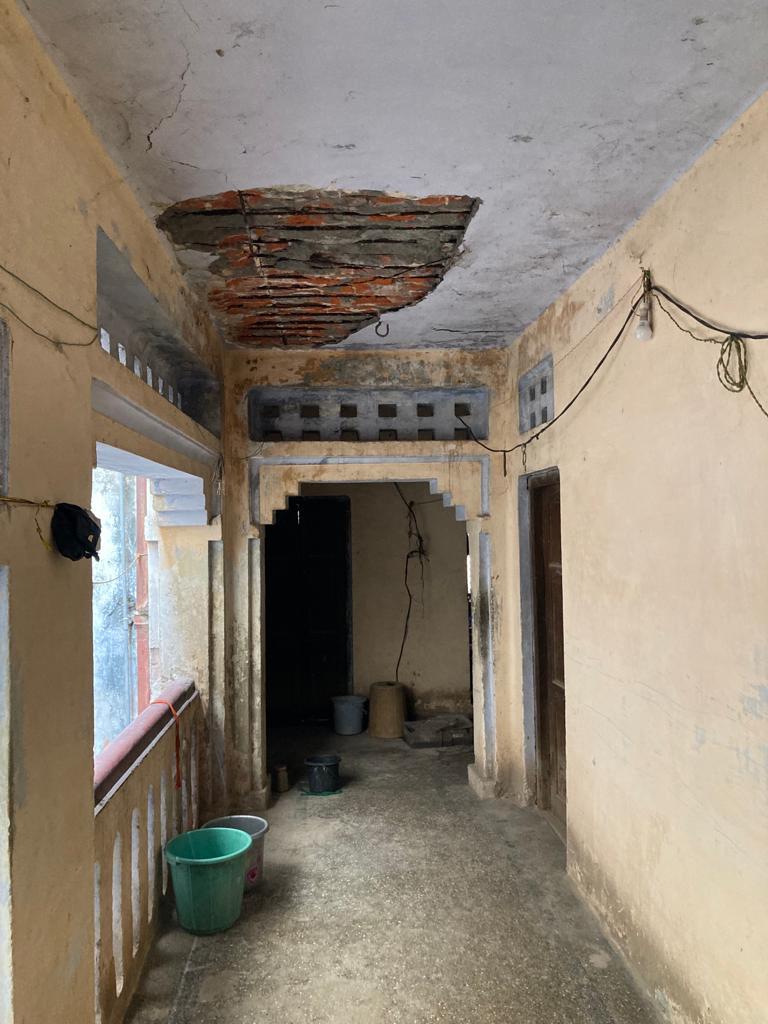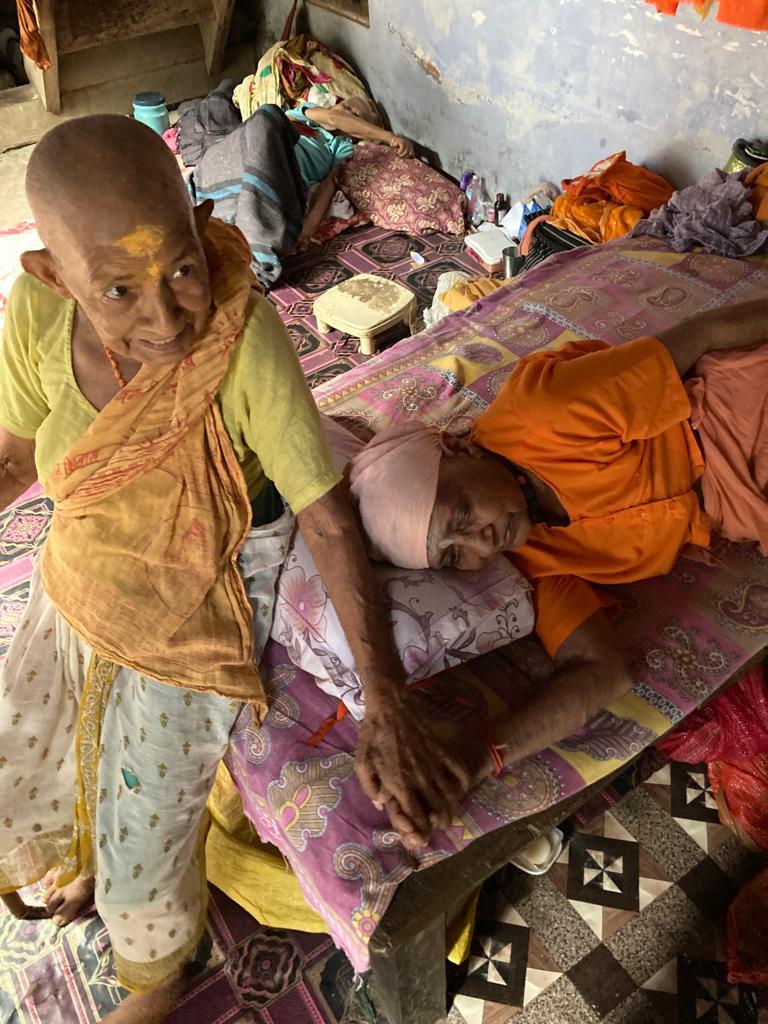Widows of Banaras: A Culture of Service in Decline?
Birla Ashram
The city of Banaras has an ancient culture of providing a safe haven to widows from across India. There are many ashrams (hermitages) in the city that provide shelter to women who want to spend the rest of their lives in religious spaces, near the Ganga river, performing Hindu rituals in temples and spending their time peacefully. After Vrindavan, Banaras is known to give shelter to a great number of such women, where they have found safety and peace.
Nirmala, a widow staying at Birla Aashram, says when she started her life in Banaras, she used to live peacefully. “We used to live peacefully, following our daily routine of snaan (bath) and puja (prayer), and we used to get alms in the form of dal and chawal (lentils and rice),” she told NewsClick. Widows were also known to be doing work related to temples, such as making cotton wicks for diyas (lamps), which became a source of small income. Thus, widows lived a relatively simpler life.
However, today, things have changed for the worse. Many of the ashrams were funded by trusts, such as Birla, Dalmia, etc. and built decades ago. Locals believe that as Banaras as a city became a hub of tourists, a tourist boom induced several changes in these ashrams. As many of these ashrams have been built near the ghats, it has been of much interest to the management of such ashrams to neglect the living conditions in the ashrams and move toward converting such buildings and spaces into guesthouses and hotels.

The Birla Ashram’s roof falling apar
One such clear sign of neglect is dwindling number of widows in these ashrams. Earlier, 20-30 widows found space in such ashrams, today the numbers are falling. This can be seen in the Birla ashram, where only two widows remain. It is a two-storeyed building with multiple rooms, but today, it houses only two people. It almost looks like a building that has been abandoned for decades.
Nirmala says new admissions to it have been stopped for unknown reasons but also points to the pathetic conditions of living and weakening of buildings. “I was living in a different room before this one, the roof of that room fell down and now I have shifted to another one. You can see the ceiling falling apart. We complained to the managers but they never let the trustees know the conditions of it,” Nirmala said. She adds that if the trustees get to know the pathetic conditions maybe the facilities and the place can be renovated.
Bachu, an old man running a paan shop beside the Birla ashram is sceptical of even the trustees. “The owners themselves have lost the will to work for the benefit of these widows. If they did, the condition of the ashram would be better than what we see today,” he told NewsClick. He adds that most dharamshalas or ashrams used to take in old women as well, even if an ashram was dedicated to widows, but now the attitude to serve people in need is vanishing among new managers and they mostly neglect even people who at present live in such ashrams.
Sanjay Jha, a priest working in the Kashi Vishwanath temple says that widows do come to Banaras, “but usually, they are rejected by such ashrams. Managers say there cannot be any new admissions,” he told NewsClick. He adds: “Ashrams started utilising this space to rent the room for tourists and guests for quick money. Hence it seems to me that the emptiness of these ashrams is due to the fact that the widows are rejected. Frustrated, they prefer other cities, like Vrindavan, Haridwar, etc. as there is no safe place for them here.”
He says usually widows who arrive in Banaras, if they cannot find a place in an ashram, will settle in and around temples and live on alms. “If they have any local contacts in Banaras, they get some help, else they visit temples and live around there,” he added.
Jha cited the example of Mithila Seva Samiti, a community space just beside Birla Ashram, which used to help widows with a place to stay, but now in the past few years, they have stopped taking in widows as well. “Now in the Samiti, only pandits (priests) and students of Sanskrit have occupied this space. Such a trend can be found in other ashrams as well,” he said.
Another local resident talks about Bengali tola, now known as a present-day locality for South Indian tourists and pilgrims to find guesthouses and hotels. “Near the Gauri-Kedareshwar temple, there used to be at least three ashrams for widows some 10 years ago. But, over time, the ashrams were purchased by South Indian businessmen and converted into guesthouses,” he told NewsClick.
Bachu laments that even though today Birla Ashram is empty and not much is going on, he expects that it soon will be converted into a hotel for profit. “These are internal problems that the management of the ashram has to deal with, as locals can only see the desolate condition of the place and widows just dying year by year, leaving this place empty,” he said.
Many widows of the ashram near the Nepali temple -- another ashram of widows -- say they are not being taken care of by the managers of the ashram. Many of them are not in the condition to walk and take care of their daily needs.
Nandini, 88, a widow in the ashram, says she is sick and has constant fever. “Nobody takes care of my medicines, and I have to manage it through the help of others here,” she told NewsClick. She has been living here for the past 60 years, her husband having died when she was only 20. One of her friends whose bed is beside her is completely bedridden and cannot be taken to the bathroom by other women who are also frail.
A similar weakening structure of the building was seen in the Nepali temple ashram as well, even as the funds to help with these and the hygiene of the place is never used for these purposes.
In both the ashrams, no new admissions have been taking place for years, as other widows inform us. The remaining ones are leaving this world one by one over the years, and that way, both the places may soon be vacant, perhaps ready for some investment.
The present condition is such that no younger widows can be seen, and most of those left are over 80 years old. Perhaps, this points to an unwelcoming culture in the city -- a city which has been known to give space and peace to widows.
Banaras has been known to many as a place where people desire to spend the rest of their lives, retiring in old age. The city folk have been at the forefront to provide services to people who desire to spend their twilight years in the city. But the apathy and neglect of widows of Banaras seems to tell us that this culture of service is in decline. Profit drives such apathy of once good-willed ashrams and organisations and philanthropists that helped widows are also on the decline.

Widows at Nepali Temple Ashram
Widows moving away from their homes and also abandoned was also a result of social ostracisation, as they were traditionally considered “harbingers of bad luck” and were denied any status in society. Thus, they usually would end up living a fairly restricted and isolated life, though a small look into 20th century Banaras shows that widows have also lived a socially engaged life. Historian Nita Kumar wrote about the imbibing of sainthood by widows of Banaras in the 20th century and committing themselves to causes such as education, especially for girl children.
With some support and their perceived “closeness to god”, widows were able to promote education of women in the city and work against conservative Hindu society that restricted access to education for women, while remaining within the Hindu fold. Thus, such reverence for widows and their social work existed in the city, but now, all seems to point in the direction that such a culture of reverence and service is in the decline.
The writers are freelance journalists. Views expressed are personal.
Get the latest reports & analysis with people's perspective on Protests, movements & deep analytical videos, discussions of the current affairs in your Telegram app. Subscribe to NewsClick's Telegram channel & get Real-Time updates on stories, as they get published on our website.
























